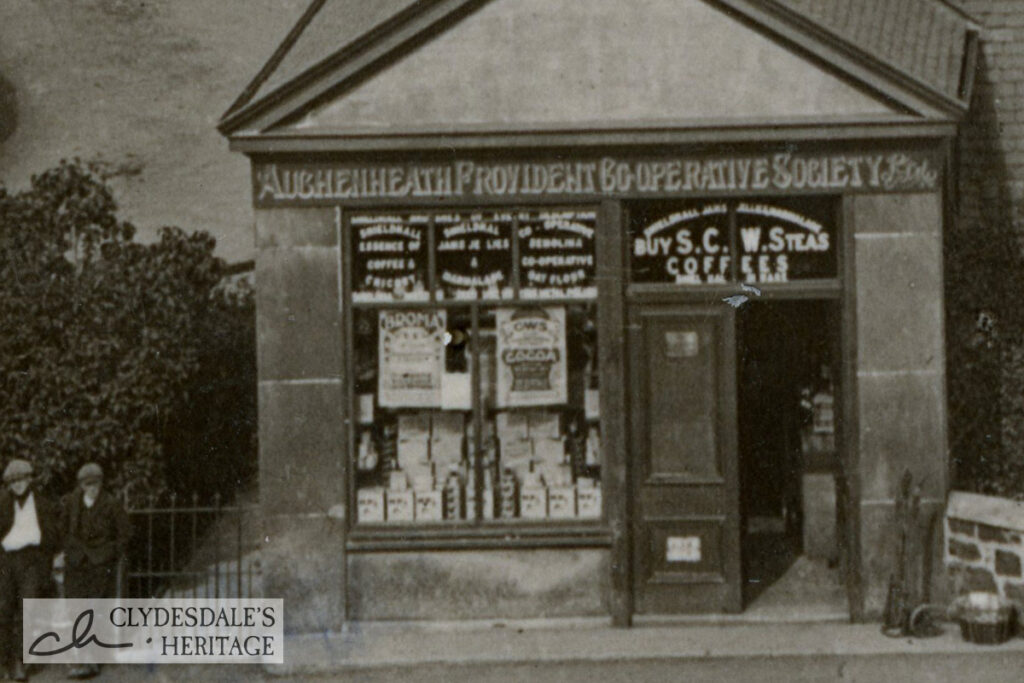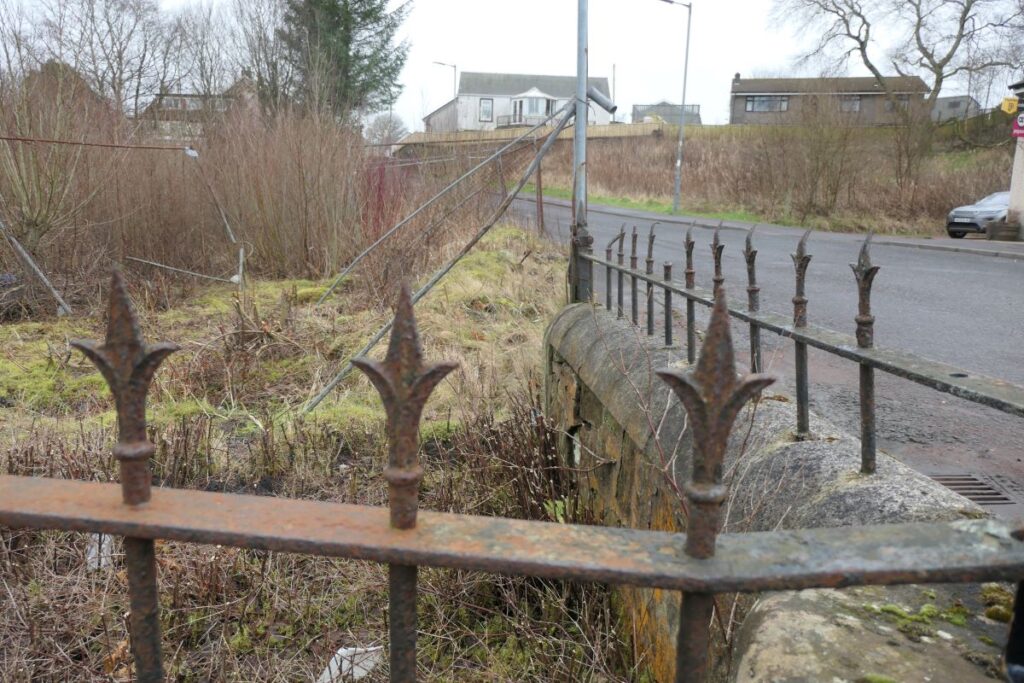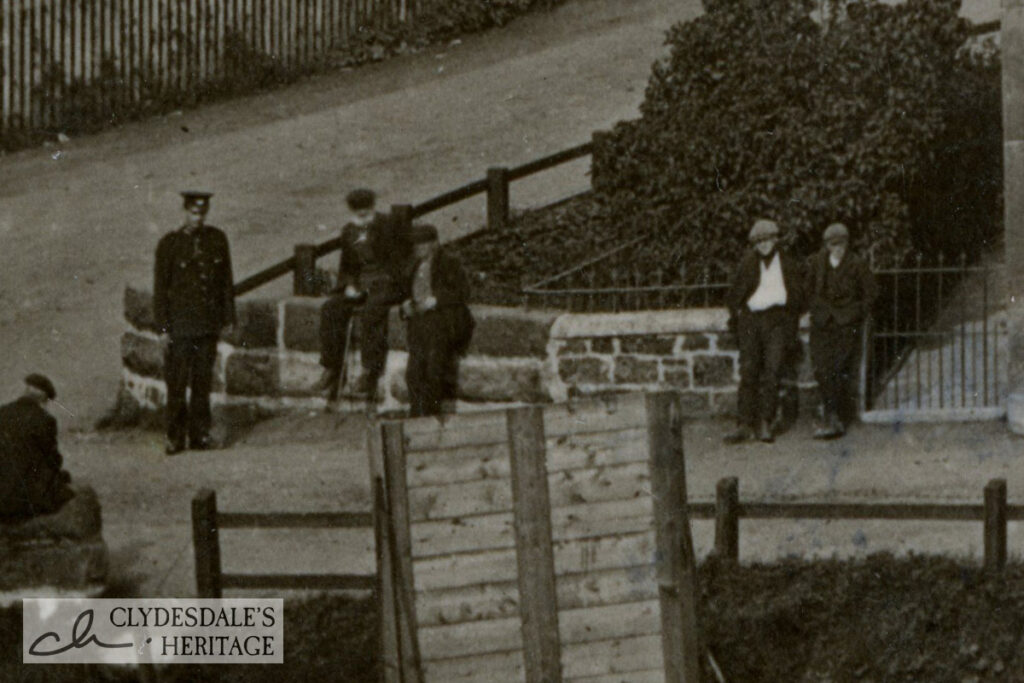
This wonderful and well-known postcard places you at a perfect elevated position from which to observe everyday life in the mining community of Coalburn. Use of a telescopic lens manages to pack a substantial distance into a small image, while the clarity of the photo is remarkable. With a magnifying glass (or digital scanner) you can even read the wording picked out in the raised enamelled letters stuck to the glass windows of the Co-op store.
It is perhaps the welcoming open door and neat window displays of the little Auchenheath Provident Co-operative Society store that catch the eye first. It is thought that the Co-op grocery opened here in about 1895, and it seems likely that the photograph was taken about a decade later. The complicated histories of this and other Co-op stores in Coalburn, and of the adjoining ivy-clad Burnside cottage, are explored in the excellent website of the Jim Hamilton Heritage Society of Coalburn. It’s a superb record and celebration of all things Coalburn.

Beside the store, on the bridge across the Coal Burn, a group of locals pass the time of day, seemingly aware of the camera. The chap in uniform might be the local postie; one grey-bearded figure has a walking stick, one has a crutch, and another seems to have his arm in a sling.


Locals on the bridge, and a camera-shy wee girl outside the Coalburn Inn
On the extreme left we see the rough stone front of the Coalburn Inn, the oldest building in the view, and the only one that would have existed when the railway first arrived in the area in the 1850’s. The curve of the palisade fence leads up to the level crossing, overseen by a fine Caledonian Railway signal box. Road traffic will not have been greatly inconvenienced by the occasional goods trains, bringing down wagons laden with coal from the Dalquhandy and Westown pits.

The brightly painted white fence marks out the platform of the railway station; the terminus of a branch from Motherwell, Larkhall, and Lesmahagow. Passenger services were not extended to Coalburn until 1891, and then only after a protracted local campaign. The hipped slate roofs that partially obscures the view of the station are those of the Station Hotel, opened soon after passenger services commenced.
The elegant stone villas that sweep up the Coalburn Road, and the more basic rows beyond, appear clean and recently built. Many will have been constructed in association with the Bellfield Colliery, developed by William Barr and Sons in the early 1890’s. The smoke-laden pitheads in the distance on the right of the picture are probably those of Bellfield No.3 and No.4 pits. These fell victim to the nationwide strike that halted coal production in 1921. Areas of the pit had flooded following a dispute over pumping arrangements, and the owners chose not to reopen once the strike ended. 600 lost their jobs, including 200 said to be resident in Lanark.

Huge changes have taken place in the 120 years since the photograph was taken. The Jim Hamilton website tells us that the railway closed in 1965, the station hotel was demolished following a fire in 1996, and the Burnside cottage (and the little coop shop) were cleared in 2008.
The old Coalburn Inn (now converted to apartments) and villas on Coalburn Road are among the few buildings that now survive. The little bridge conducting the Coal Burn beneath the road is little changed, as are the stone parapets and a short length of stone wall topped with cast iron spikes. This little spot would be recognisable to the postie, the pensioners, and the injured men, should they ever return.



25″ OS map c.1909, courtesy of National Library of Scotland. The message on the rear of the card – the publisher James Adam ran the Coalburn post office. Newspaper report of a tragedy at the level crossing that occurred in 1897.




Photos taken Boxing Day 2024
Unless otherwise stated, all text, images, and other media content are protected under copyright. If you wish to share any content featured on Clydesdale's Heritage, please get in touch to request permission.




